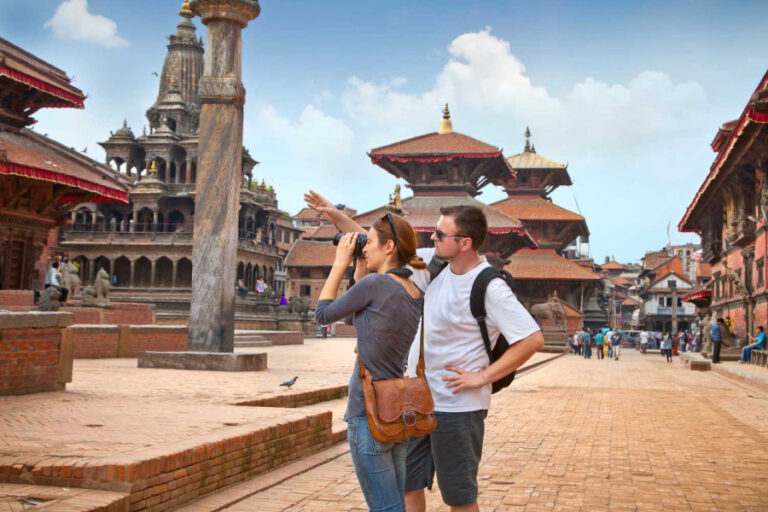Nepal’s tourism sector generated revenue of 327.9 billion rupees ($2.5 billion) last year and supported 1.19 million jobs directly and indirectly, according to a recently released World Travel and Tourism Council annual report. The report projects that Nepal will generate 1.22 million jobs in 2024.
The tourism sector generates 15.2 percent of the total employment.
Travel and tourism contributed 6.6 percent of the country’s gross domestic product (GDP) last year to 358.9 billion rupees ($2.7 billion), down from 6.7 percent in 2019, before the coronavirus pandemic began, the London-based group said.
All values are constant at 2023 prices and exchange rates.
It primarily reflects economic activity generated by sectors such as hotels, travel agencies, airlines and other passenger transport services, but excludes commuter services. It also includes activity in the restaurant and leisure industries that are directly supported by tourists.
Domestic tourists are the largest spenders, having spent Rs 210.8 billion last year and are expected to spend Rs 226.8 billion this year, which is 71.5 percent of the tourism sector’s total spending, according to the annual report.
According to hoteliers, Nepalese people began touring their country in significant numbers after the 2015 earthquake.
Traditional leisure destinations like Pokhara and Chitwan, as well as the famous Annapurna Base Camp trail, Mardi and Manaslu treks, were major attractions for adventurers in the country, but tourism came to a halt due to the COVID-19 pandemic.
“Domestic tourism has now fully recovered,” said Mani Raj Lamichhane, director of research, planning and monitoring at the Nepal Tourism Board (NTB).
“Though we do not have actual data on domestic travel, based on occupancy rates reported by hotels in major tourist hubs such as Pokhara and Chitwan, the increase in domestic tourists is phenomenal,” Lamichhane said.
“While the impact on Pokhara has been less due to poor road conditions, domestic tourist movement in Lumbini has come down considerably.”
Domestic airlines have reported robust passenger traffic to destinations such as Pokhara, Bhairahawa and Bharatpur due to ongoing road expansion projects.
“We operate 40 flights. [landing and takeoff] “The number of flights from Pokhara International Airport has doubled in the past six months,” said Dipendra Karuna, public relations manager for Buddha Air, Nepal’s largest domestic airline.
Buddha Air operates 34 flights on the Pokhara-Kathmandu-Pokhara route, connecting Pokhara with Nepalgunj, Bhairahawa and Bharatpur.
On April 14, Buddha Air recorded its highest daily passenger numbers to date, carrying 3,000 passengers to and from Pokhara.
Karna said most passengers at major tourist destinations were Nepalese, followed by Indians.
“Pokhara has a 95 percent occupancy rate,” Karuna said.
Moreover, after the construction of the Beni-Jomsom road, the number of tourists travelling by motorbike from Beni to Jomsom has also increased sharply.
International tourists spent an estimated 83.9 billion rupees ($633.7 million) last year, the report said, a figure that is projected to rise to 102.6 billion rupees in 2024.
Of the total expenditure, 83.4% was spent on leisure and the rest on business.
The country welcomed more than one million tourists between January and December last year after China reopened its borders and tourism from India hit a record high.
According to the Nepal Tourism Board, the country’s tourism promotion agency, visitor numbers exceeded one million for the first time in four years.
Through its budget, the government announced it plans to attract 1.6 million foreign tourists this year.
Industry insiders say the government’s target is achievable but there are some challenges this year.
Kathmandu’s Tribhuvan International Airport will be closed for 10 hours daily, from 10 pm to 8 am, for five months from November 8 to March 31 for taxiway expansion.
September to November is the peak tourist season in Nepal.
“Construction works during peak season may result in reduced flight frequencies and therefore higher airfares,” Lamichhane said.
Subhash Jha, spokesman for Kathmandu’s Tribhuvan International Airport, said at least 12 flights could be affected. “It is difficult to reschedule as there are no tarmac spaces during the day. But we have asked airlines to use Nepal’s two new international airports in Pokhara and Bhairahawa and we are ready to help with that.”
Jha said talks had been concluded with several foreign airlines to ensure flights were not affected. “It is up to the airlines whether they are willing to operate from the new airport or not. But we cannot force them,” he said.
Moreover, industry insiders said Nepal Tourism has been without a top leader for the past four months, which has affected all international promotional and marketing events.
The number of foreign tourists visiting the country in 2018 reached 1.17 million, exceeding the one million mark for the first time.
That number reached 1.19 million in 2019. But tourism stopped when the COVID-19 pandemic began in early 2020. Travel restrictions and the economic slowdown caused by the pandemic dealt a major blow to Nepal’s burgeoning tourism industry, with revenue and profits plummeting since 2020.
Nepal received 230,085 and 150,962 tourists in 2020 and 2021, respectively. In 2022, the number of foreign tourists surged to 614,869.

